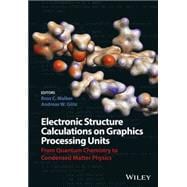Electronic Structure Calculations on Graphics Processing Units: From Quantum Chemistry to Condensed Matter Physics provides an overview of computing on graphics processing units (GPUs), a brief introduction to GPU programming, and the latest examples of code developments and applications for the most widely used electronic structure methods.
The book covers all commonly used basis sets including localized Gaussian and Slater type basis functions, plane waves, wavelets and real-space grid-based approaches.
The chapters expose details on the calculation of two-electron integrals, exchange-correlation quadrature, Fock matrix formation, solution of the self-consistent field equations, calculation of nuclear gradients to obtain forces, and methods to treat excited states within DFT. Other chapters focus on semiempirical and correlated wave function methods including density fitted second order Møller-Plesset perturbation theory and both iterative and perturbative single- and multireference coupled cluster methods.
Electronic Structure Calculations on Graphics Processing Units: From Quantum Chemistry to Condensed Matter Physics presents an accessible overview of the field for graduate students and senior researchers of theoretical and computational chemistry, condensed matter physics and materials science, as well as software developers looking for an entry point into the realm of GPU and hybrid GPU/CPU programming for electronic structure calculations.








